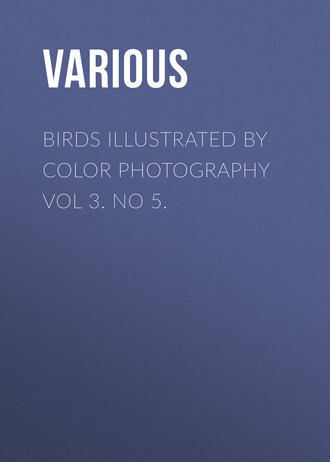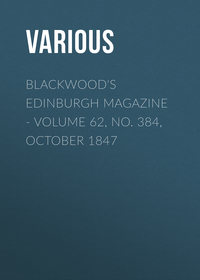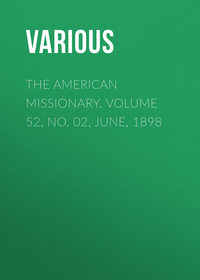 полная версия
полная версияПолная версия
Birds Illustrated by Color Photography Vol 3. No 5.
THE ENGLISH SPARROW
When the English Sparrow (see Birds, Vol. II, p. 208), was first introduced into Canada, we are informed by Mr. Albert Webber, the city of Hamilton provided for its protection by causing to be erected a large iron pole, on which was set a huge box containing many apartments, the pole surrounded by a circular iron railing. Each day during the winter a sheaf of oats was attached to the pole. In a year or two the Sparrows became so numerous that the authorities were obliged to abandon the project of contributing to the support of the birds and left them to shift for themselves. They soon found, however, that the little foreigners were quite independent of the city fathers.
Indefatigable, persistent, industrious breeders – at once rebuilding their nests, if destroyed by accident or otherwise – there is little hope of their extermination, if such action should be desired in the future. Mr. Thomas Goodearl, an observer of these birds in their nativity, predicts that the English Sparrow will be the survivor – though not the fittest – of all English birds.
C. C. M.THE PIN-TAIL DUCK
It was my cousin the Teal who said he was not born to sing and look pretty flitting among the trees, but was a useful bird, born to be "done brown" and look pretty in a dish. Well, I am one of that kind, too.
Pin-tail, Sprig-tail, Sharp-tail, Water Pheasant. I am known by all of these names, though people only use one at a time, I believe.
You will find us Pin-tails generally in fresh water. We move in very large flocks, in company with our cousins the Mallards, feeding and traveling with them for days. But when it comes to flying we distance them everytime. Our flight is rapid and graceful, the most graceful, they say, of all the Duck tribe.
Instead of a song we have a call note, a low plaintive whistle which we repeat two or three times. It is easily imitated, and often, thinking a companion calls us, we swim in the direction of the sound, when "bang" goes a gun and over flops one or more Pin-tails.
We have other enemies beside man, and have to keep a sharp lookout all the time. Way up north one day, a Fox stood on the borders of a lake and watched a flock of Ducks feeding among the rushes. He was very hungry and the sight of them made his mouth water.
"How can I get one of those fine, fat fellows for my dinner," he muttered, and Mr. Fox, who is very cunning, you know, remained very quiet, while he thought, and thought, and thought.
"Oh, I have it!" he presently exclaimed, and going to the windward of the Ducks, set afloat a lot of dead rushes or grass, which drifted among the flock, causing no alarm or suspicion whatever.
Then Mr. Fox, taking a bunch of grass in his mouth, slipped into the lake, and with nothing but the tips of his ears and nose above the water, drifted down among the rushes and the Ducks, too.
Such a squawking as there was, when Mr. Fox opened his red mouth, seized the largest of the flock, and with a chuckle put back for the shore.
"Hm!" said he, after enjoying his dinner, "what stupid things Ducks are to be sure."
A mean trick, wasn't it? Nobody but a Fox – or a man – would have thought of such a thing. I'd rather be an innocent Duck than either of them though my name is Pin-tail. Wouldn't you?
THE PINTAIL DUCK
ALL the Ducks are interesting, and few species of the feathered creation, in shape, color, beauty, and general variety of appearance present more that is attractive to the student of ornithology. Aside from their utility as destroyers of much that is obnoxious to vegetation and useful animal life, and as a desirable, if not indispensable, food for man, they possess characteristics that render them interesting and instructive subjects for investigation and study.
Among them this widely distributed fresh water Duck is one of the best known. Its name describes it well. It is one of the first arrivals in the spring. The Pintail haunts wet prairies, mud flats, and the edges of reedy, grassy waters, feeding largely upon bulbous roots, tender shoots, insects and their larvae, worms and snails, and, on its return in the fall, upon various seeds, water plants, and grain. Acorns have been frequently taken from the crops of these Ducks.
The Pintail, according to Goss, seldom dives, and it never does so while feeding, but in searching in the water for its food immerses not only the head but a large portion of the body. It is an odd sight to see a flock thus tipped up and working their feet in the air, as if trying to stand upon their heads. They move about with a graceful motion of the head, and with tail partially erect, and upon the land step off with a dignity of carriage as if impressed with the thought that they are no common Duck. In flight they are very swift.
The nest of the Pintail is placed on low but dry, grassy land and not far from water, usually under the shelter of a bush, and is a mere depression in the ground, lined with grasses and down. There are from seven to ten eggs, of pale green to olive buff, in form oval and ovate.
The habitat of the Pintail Duck is the northern hemisphere in general; in North America it breeds from the northern United States northward to Iceland and south in winter to Cuba and Panama.
Mr. George Northrup, of long experience on Calumet lake and river, Illinois, says that only a few years ago there were to be seen on these waters during the seasons of migration as many as a million, perhaps millions, of Ducks, among which were multitudes of Pintails. He has seen the lake so covered with them that there seemed to be no room whatever for more, though others continued to alight. The hunters were delighted with the great opportunities these vast flocks presented for slaughter – sport, as they called it; mania, Mr. Northrup characterized it. He said the birds, at the very earliest indication of day, hurried on swift wing to their feeding grounds to get their breakfasts, where the sportsmen were usually awaiting them.
The Pintail Duck is not regarded as so great a delicacy as the Canvasback, the Red Head, or even the Mallard, yet when fat, young, and tender it is a very palatable bird, and well esteemed for its flavor. The cook probably has something to do with its acceptableness when served, for
No Duck is bad when appetiteWaits on digestion.FEATHERS OR FLOWERS?
WAS the question which confronted the fair sex this year when about to select their Easter hats or bonnets.
"Say flowers," pleaded the members of the Audubon Society, and from the many fair heads, innocent of feather adornment, which bowed before the lily-decked altars on Easter morning, one must believe that the plea was heeded.
Nearly every large house in Chicago, dealing wholly or in part in millinery goods, was visited by a member of the Audubon Society, says the Tribune. One man who sells nothing but millinery declared that the bird protective association was nothing but a fad, and that it would soon be dead. He further said he would sell anything for hat trimming, be it flesh, fish, or fowl, that a woman would wear.
Touching the question whether the beautiful Terns and Gulls, with their soft gray and white coloring, were to be popular, it was said that they would not be used as much as formerly. One salesman said that he would try, where a white bird was requested, to get the purchaser to accept a domestic Pigeon, which was just as beautiful as the sea and lake birds named.
The milliners all agree that the Snowy Egret is doomed to extermination within a short time, its plumes, so fairy-like in texture, rendering its use for trimming as desirable in summer as in winter.
As to the birds of prey, people interested in our feathered friends are as desirous of saving them from destruction as they are to shield the song birds. There are only a few of the Hawks and Owls which are injurious, most of them in fact being beneficial. Hundreds of thousands of these birds were killed for fashion's sake last fall, so that this coming season the farmer will note the absence of these birds by the increased number of rat, mouse, and rabbit pests with which he will have to deal.
It is a matter of congratulation, then, to the members of the Audubon Society to know that their efforts in Chicago have not been wholly fruitless, inasmuch as the majority of dealers in women's headgear are willing to confess that they have felt the effect of the bird protective crusade.
Dr. H. M. Wharton, pastor of Brantly Baptist Church, Baltimore, has always been a bitter opponent of those who slaughter birds for millinery purposes. "It is wholesale murder," said he, "and I am delighted that a bill is to be offered in the Maryland legislature for the protection of song birds. I have commented from the pulpit frequently upon the evil of women wearing birds' wings or bodies of birds on their hats, for I have long considered it a cruel custom."
"Birds are our brothers and sisters," said the Rev. Hugh O. Pentecost before the Unity Congregation at Carnegie Music Hall, Pittsburg, a few weeks ago. "If we are children of God, so are they. The same intelligence, life, and love that is in us is in them. The difference between us is not in kind, but in degree."
"How is this murderous vanity of women to be overcome?" asks Our Animal Friends. "We confess we do not know; but this we do know, that good women can make such displays of vanity disreputable, and that good women ought to do it."
THE DOUBLE YELLOW-HEADED PARROT
HERE we have a picture of the best, with possibly one exception, the African Gray, of the talking parrots. Its home is in Mexico, about the wooded bottoms of La Cruz river, in the province of Taumaulipas, on the east coast. It is a wild, picturesque region of swamps, jungles, and savannahs, with here and there a solitary hacienda or farm-house, where three hundred or four hundred persons are at work in the fertile soil. Here, three hundred miles south of Matamoras, the nearest American settlement, is the spot where your pet Parrot, says an exchange, probably first opened its eyes to the light of day stealing through the branches of the ebony and coma trees, amid surroundings that might to an imaginary Polly suggest the first dawn of creation. The forests in this region abound in all kinds of birds in rich plumage. Parrakeets are so abundant that what with the screeching and cawing of the Parrots it is sometimes impossible to hear one's own voice. Hunters do not trouble themselves to secure them, however, as they are not worth carrying to market. There is apparently a profit only in the Double Yellow-head, for which the hunters get as much as $20.00. There are two kinds of Mexican Parrots, both of which are held in far different esteem. The only Mexican Parrot that is in general demand as a talking pet is the Double Yellow-head, which with age develops a yellow hood that extends completely over its head and shoulders. In connection with the "speaking" of Parrots, one of the most curious circumstances is that recorded by Humboldt, who in South America met with a venerable bird which remained the sole possessor of a literally dead language, the whole tribe of Indians who alone had spoken it having become extinct.
The Parrot builds no nest. The female selects a deep hollow in the highest tree trunk and there lays two eggs. This occurs about the first of May. The young are hatched about the 15th of June, ten days elapse before they can open their eyes, and several weeks must be allowed for the young birds to outgrow their squab state and gain sufficient strength to be removed from the care of their parents. The Parrot is a wily and wise bird. It lays its eggs safely out of reach of ordinary danger and takes good care not to betray their whereabouts. When the young birds are hatched they are fed twice a day by their elders, early in the morning and again about the close of day. The birds in feeding their young give vent to a series of contented clucks and chuckles, which is answered by the young ones. These birds live on mangoes and the nuts of the ebony tree.
Newton observes, that considering the abundance of Parrots both as species and individuals, it is surprising how little is known of their habits in a wild state.
It is probable that no other bird has been more admired or more thoroughly execrated. If it is good natured, is an interesting talker, and you happen to be in a mood to listen to it with some pleasure, you will speak favorably of the bird, saying to it: "Pretty Polly! pretty Polly!" but should your nerves be unstrung and every noise a source of irritation, the rasping, high-pitched screech of a Parrot, which is a nuisance in any neighborhood, will be beyond endurance. We shall always be satisfied with the possession of Polly's picture as she was.
THE DOUBLE YELLOW-HEADED PARROT
I came from Mexico. Once I talked Spanish, but at the present time I speak the English language altogether. Lucky, isn't it? My neck might be wrung did I cry "Viva Espana!" just now.
The reason why I spoke Spanish in Mexico was because I boarded with a Spaniard there; now I live in the United States and make my home with an American family. As I only repeat what I hear I must, of course, talk just as they do.
I was born, however, in the finest Parrot country in the world. My mother built her nest in a deep hollow in the highest tree trunk in a swamp or jungle, and there laid just two eggs. She was wise to choose a high tree, for there she thought her nest was out of danger.
When we were hatched, my brother and I, our parents fed us only twice a day, in the early morning and late evening. Two meals a day was enough for little babies, my mother said.
Well, maybe it was, but in our case it would have been better had she not fed us at all. You see the Parrot hunters were about, and as my parents always kept up such a loud "clucking" when feeding us, and we did the same, why, the hunters found out in which tall tree we lived.
It was easy then for a "peon" or poor Mexican to climb the tree, and so all of our family were made prisoners. Being Double Yellow-headed Parrots we were very valuable because we can talk. My master paid $20.00 for me.
The gentleman who owns me now sells tickets in a theatre. My cage hangs near the window, and I used to hear him say when there was a rush to buy tickets, "One at a time, gentlemen; one at a time, please!" I hadn't learned to speak English very well, then, but I heard the sentence so often that I stored it up for future use.
My master, one day, went to the country and took me with him. The sight of the trees made me think of my old home, so I escaped from the cage and flew off to the woods.
They searched for me all day but not till nightfall did they find me. Such a sorry looking bird as I was, sitting far out on the end of a limb of a tree, with my back humped, and half the gay feathers plucked out of me. Around me were a flock of Crows, picking at me whenever they got a chance.
"One at a time, gentlemen," I kept saying, hitching along the limb, "one at a time, please;" but instead of tickets they each got a feather.
SPRING THOUGHTS
AND now there is such a fiddling in the woods, such a viol creaking of bough on bough that you would think music was being born again as in the days of Orpheus. Orpheus and Apollo are certainly there taking lessons; aye, and the Jay and Blackbird, too, learn now where they stole their "thunder." They are perforce, silent, meditating new strains.
* * * *Methinks I would share every creature's suffering for the sake of its experience and joy. The Song Sparrow and the transient Fox-colored Sparrow, have they brought me no message this year? Is not the coming of the Fox-colored Sparrow something more earnest and significant than I have dreamed of? Have I heard what this tiny passenger has to say while it flits thus from tree to tree? God did not make this world in jest, no, nor in indifference. These migratory Sparrows all bear messages that concern my life. I love the birds and beasts because they are mythologically in earnest. I see the Sparrow chirps, and flits, and sings adequately to the great design of the universe, that man does not communicate with it, understand its language, because he is not alone with nature. I reproach myself because I have regarded with indifference the passage of the birds. I have thought them no better than I.
* * * *I hear the note of a Bobolink concealed in the top of an apple tree behind me. Though this bird's full strain is ordinarily somewhat trivial, this one appears to be meditating a strain as yet unheard in meadow or orchard. He is just touching the strings of his theorbo, his glassichord, his water organ, and one or two notes globe themselves and fall in liquid bubbles from his tuning throat. It is as if he touched his harp within a vase of liquid melody, and when he lifted it out the notes fell like bubbles from the trembling strings. Methinks they are the most liquidly sweet and melodious sounds I ever heard. They are as refreshing to my ear as the first distant tinkling and gurgling of a rill to a thirsty man. Oh, never advance farther in your art; never let us hear your full strain, sir! But away he launches, and the meadow is all bespattered with melody. Its notes fall with the apple blossoms in the orchard. The very divinest part of his strain drops from his overflowing breast singultim, in globes of melody. It is the foretaste of such strains as never fell on mortal ears, to hear which we should rush to our doors and contribute all that we possess and are. Or it seemed as if in that vase full of melody some notes sphered themselves, and from time to time bubbled up to the surface, and were with difficulty repressed.
– Thoreau.THE MAGNOLIA WARBLER
IN this number of Birds we present two very interesting specimens of the family of Warblers, the Magnolia or Black and Yellow Warbler, ranking first in elegance. Its habitat is eastern North America as far west as the base of the Rocky Mountains. It breeds commonly in northern New England, New York, Michigan, and northward. According to Mr. William Brewster it is found everywhere common throughout the White Mountains of New Hampshire. Its favorite resorts are little clumps of firs and spruce shrubs, also willow thickets near streams and ponds and other damp places. "Its gay colors and sprightly song will at once attract the attention of even the casual observer. The nest is usually placed in the horizontal twigs of a fir or spruce at heights ranging from four to six feet, five being the average elevation, and the favorite localities are the edges of wood paths, clearings, or roads bordered by woods. Sometimes the nests are built in the tops of young hemlocks ten or fifteen feet up, or in the heart of the forest thirty-five feet above the ground." Mr. Brewster describes the nest as loosely put together, of fine twigs, preferredly hemlock, coarse grasses and dry weed-stalks. The lining is fine black roots, closely resembling horse-hair. The eggs are four, very rarely five, of creamy white, spotted and blotched with various shades of reddish brown, hazel and chestnut. The markings are generally large and well defined and often form wreaths about the larger ends.
Ridgway mentions the Magnolia Warbler as "one of the most agile of its tribe, its quick and restless movements being more like those of the Redstart than those of its nearest kindred. The tail is carried somewhat elevated and widely expanded, to display the broad white band across the middle portion of the inner web of the feathers, which together with the bold contrasts of black, yellow, and blue-gray of the plumage, render it both conspicuous and beautiful."
Mr. Langille describes the song of the Magnolia Warbler as "a loud, clear whistle, which may be imitated by the syllables chee-to, chee-to, chee-tee-ee, uttered rapidly and ending in the falling inflection."
I CAN BUT SING
"O little bird of restless wing,Why dost thou sing so sweet and loud?Why dost thou sing so strong and proud?Why dost thou sing?""Oh I have drunk the wine of spring,My mate hath built a nest with me:My hope flames out in song," said he,"I can but sing."BIRDS PAIRING IN SPRING
TO the deep woodsThey haste away, all as their fancy leads,Pleasure, or food, or secret safety prompts;That nature's great command may be obeyed,Nor all the sweet sensations they perceiveIndulged in vain. Some to the holly hedgeNestling, repair, and to the thicket, some;Some to the rude protection of the thornCommit their feeble offspring; the cleft treeOffers its kind concealment to a few,Their food its insects, and its moss their nests;Others apart, far in the grassy daleOr roughening waste their humble texture weave;But most in woodland solitudes delight,In unfrequented glooms or shaggy banks,Steep, and divided by a babbling brook,Whose murmurs soothe them all the livelong day,When by kind duty fixed. Among the rootsOf hazel pendent o'er the plaintive stream,They frame the first foundation of their domes,Dry sprigs of trees, in artful fabric laid,And bound with clay together. Now 'tis noughtBut restless hurry through the busy air,Beat by unnumbered wings. The swallow sweepsThe slimy pool, to build his hanging houseIntent; and often from the careless backOf herds and flocks a thousand tugging billsSteal hair and wool; and oft when unobserved,Pluck from the barn a straw; till soft and warm,Clean and complete, their habitation grows.As thus the patient dam assiduous sits,Not to be tempted from her tender taskOr by sharp hunger or by smooth delight,Though the whole loosened spring around her blows,Her sympathizing lover takes his standHigh on the opponent bank, and ceaseless singsThe tedious time away; or else suppliesHer place a moment, while she suddenly flitsTo pick the scanty meal.– James Thomson.THE GREAT BLUE HERON
Grotesque and tall, he stands erect,Where the reed-riffle swirls and gleams.Grave, melancholy, circumspect —A hermit of the streams. – Ernest McGaffey.ERRONEOUSLY called Sandhill Crane or Blue Crane, by which names it is better known than by its proper name, this bird is well known as one of the most characteristic of North America, breeding, as it does, singly and in colonies from the Arctic regions southward to the West Indies and South America. In the warmer parts of the country it breeds in vast heronries in company with other species of Herons, of which there are eleven or twelve, to which places they resort year after year. It is a common bird, except in localities far removed from streams or ponds which furnish its food supply.
This solitary and wary bird is usually seen standing in shallow water, often in mid-stream, but it requires great caution and skill on the part of the person who would observe its movements to get a view of him, as he usually first sees the intruder, and startles him by his harsh squawking cries as he flies from his feeding place.
The nests are placed in trees along rivers, usually the largest. They are bulky structures of sticks on the highest branches, a dozen or more nests sometimes being built in one tree. In localities destitute of trees the nests are built on rocks. Sycamore trees are favorite resorts of these birds, the light color of the limbs and the peculiar tint of the foliage harmonizing so well with their plumage as to render their presence difficult of detection.
The Heron's food consists of fishes, frogs, crawfish, and the like, large quantities of which must be sacrificed to appease its voracious appetite, as many as ten good-sized fishes having been disgorged at one time by a Heron that was in haste to get away, a happy provision of nature which often enables this family of birds to escape from the squirrel hunters and irresponsible gun-carriers.
The eggs of this species are plain greenish-blue and three or four in number. The young are without plumes, which develop gradually with maturity.
Dr. Neill mentions a curious instance of the Heron feeding on young Water-hens. A large old willow tree has fallen down into the pond, and at the extremity, which is partly sunk in the sludge and continues to vegetate, Water-hens breed. The old male Heron swims out to the nest and takes the young if he can. He has to swim ten or twelve feet, where the water is between two and three feet deep. His motion through the water is slow, but his carriage stately. He has been seen to fell a rat at one blow on the back of the head, when the rat was munching at his dish of fish.











